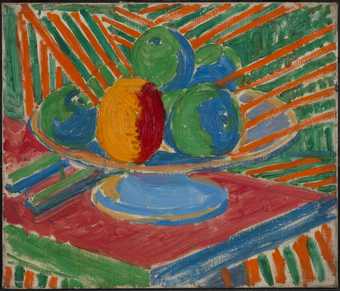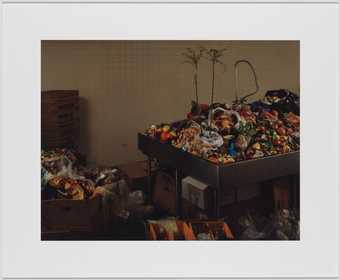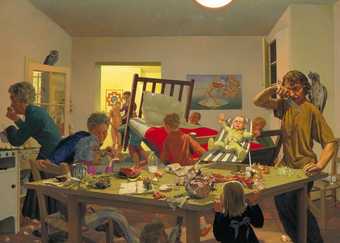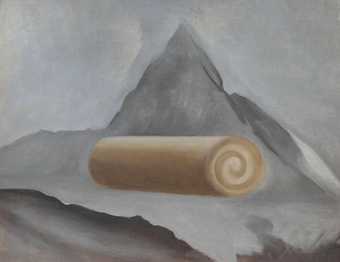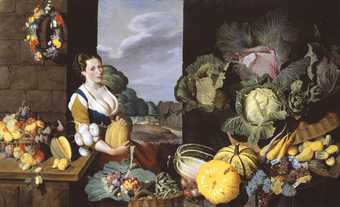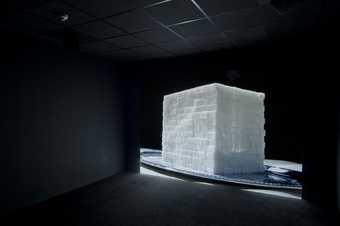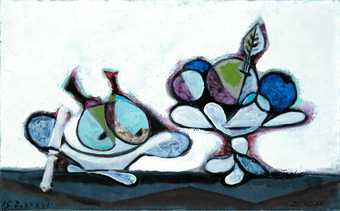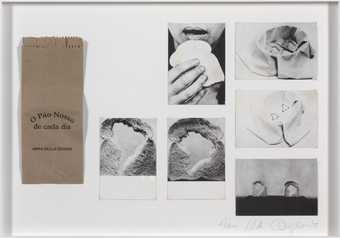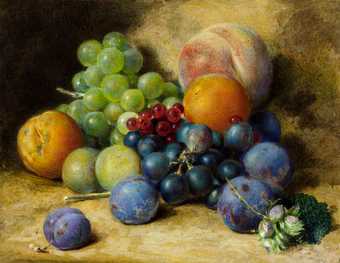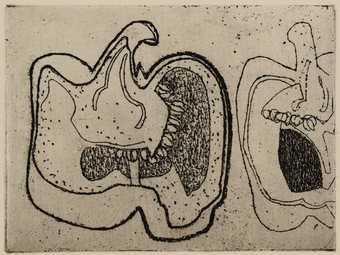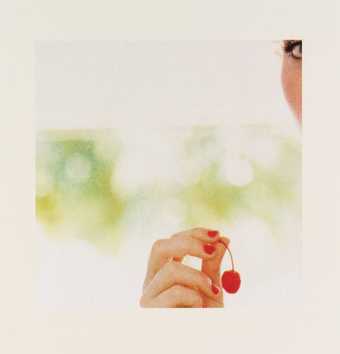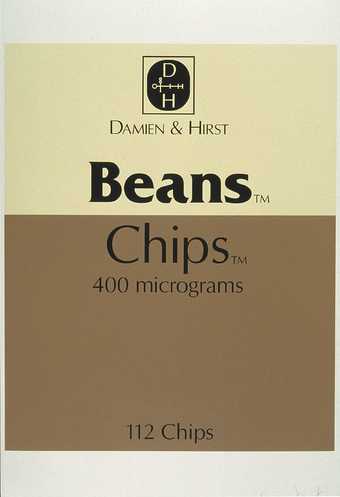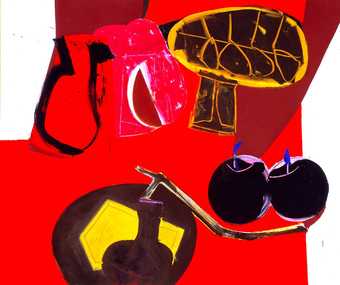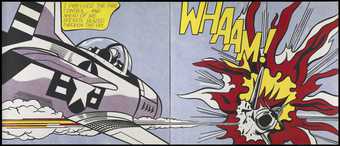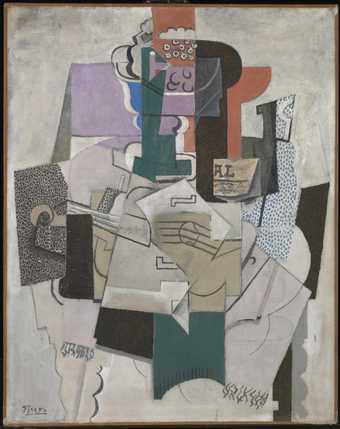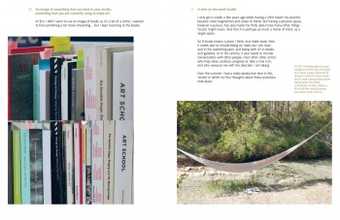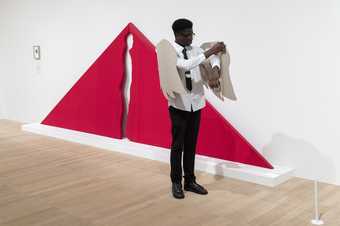For starters…tuck into pictures of people eating
Food is such a big topic – where do you even start? The great thing about making art about food is that it is all around you. Even the humblest snacks or everyday family meals can be a source of inspiration.
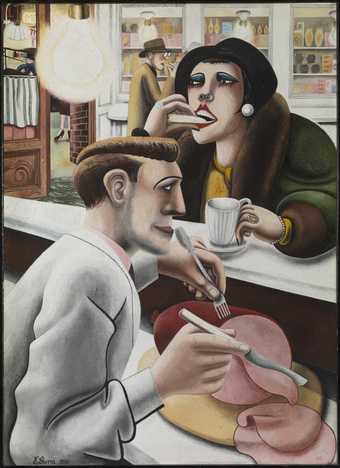
Edward Burra
The Snack Bar
(1930)
Tate
© The estate of Edward Burra, courtesy Lefevre Fine Art, London
In Snack Bar, Edward Burra translates the ordinary scene of people eating into one of humorous tension as the couple tucking into their snacks look almost sinister in the harsh lighting of the café interior. While Jonathan Learman turns a scene of cooking a family meal into one of chaos and devastation in his painting in A Jan Steen Kitchen 1995-6. Uta Barth’s Untitled photograph presents a much calmer picture of eating. The unexpected crop of the photograph creates a simple but surprisingly powerful composition in which the inviting vibrant red of a cherry, echoed in the painted fingernails of the hand holding it, becomes the subject of the work.
Textures, colours and shapes
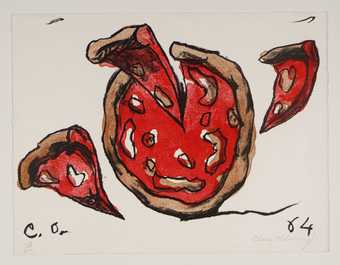
Claes Oldenburg
Pizza Pie
(1964)
Tate
Artist Claes Oldenburg took inspiration from a simple pizza recreating its rough bubbly surface in Pizza Pie with a few wobbly marks and a hot red colour. In Counter and Plates with Potato and Ham, he transforms this humble meal into an luscious abstract surface – the enjoyment of food reflected in his sensuous use of colour and textures.
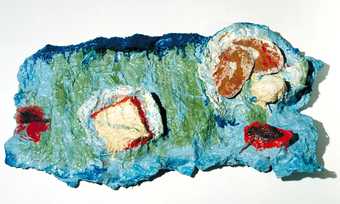
Claes Oldenburg
Counter and Plates with Potato and Ham
(1961)
Tate
Prunella Clough gets right up-close to her subject in Pimentoes. Using simple lines she explores the shapes of the seeds and structure of the halved pepper, translating them into an almost abstract pattern of shapes and lines. Clough looks closely – other artists step back to use the shapes, textures and colours of fruit as the source for abstracted compositions. By using bold complementary colours Matthew Smith transforms his fruit in a dish into a powerful buzzing composition. The cubists playfully mess around with the shapes and textures of food in their still life paintings and collages. In Picasso’s Bowl of Fruit, Violin and Bottle 1914, the grapes have been reduced to a huddle of curved marks, an apple to a simple curve, while other objects in the painting seem to take on textures of fruit – bumps and dots reminiscent of the surface of an orange.
Go pop!
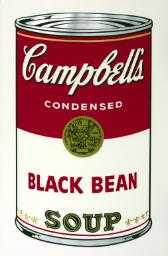
Andy Warhol
Black Bean
(1968)
Tate
© 2024 The Andy Warhol Foundation for the Visual Arts, Inc. / Licensed by DACS, London
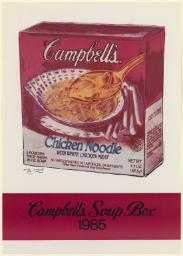
Andy Warhol
Campbell’s Soup Box 1985
(1985)
ARTIST ROOMS Tate and National Galleries of Scotland
© 2024 The Andy Warhol Foundation for the Visual Arts, Inc. / Licensed by DACS, London
Pop artists also explored the textures and colours of food – especially food packaging. Perhaps the most iconic pop representations of food are Andy Warhol’s soup cans as seen in Black Bean. British pop artist Eduardo Paolozzi also included food in his collages. Soda pop and plates of food are juxtaposed with other magazine images of ideal lifestyles and shiny luxury goods.
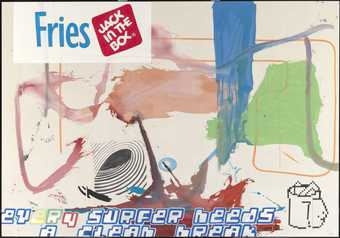
Michel Majerus
Fries
(2001)
Tate
© The estate of Michel Majerus, courtesy neugerriemschneider, Berlin
In the spirit of pop art, artist Michel Majerus, features a box of chips in Fries 2001 along with logos and mass produced products…but adopts this imagery to celebrate youthful subcultures that use images of consumerism as badges of identity, rather than subverting consumer culture, as the pop artists did. Damien Hirst was also inspired by packaging in his series of food-related prints The Last Supper. For these he used packaging usually associated with medicines, but replaced the name of the drug with the name of a food traditional to working class British café culture, for example ‘corned beef’, ‘sausages’, or ‘beans’ and ‘chips’ transforming the food into a brand by the addition of the insignia ®, TM or decorative typescript.
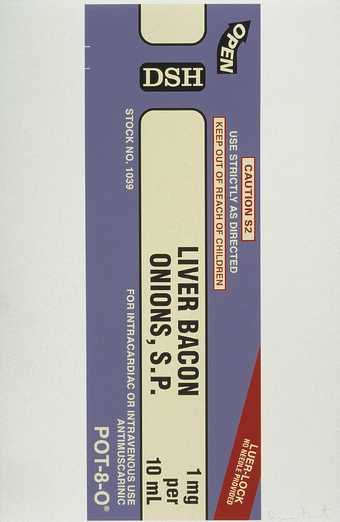
Damien Hirst
Liver Bacon Onions
(1999)
Tate
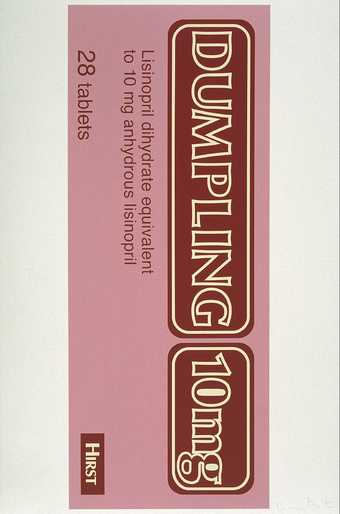
Damien Hirst
Dumpling
(1999)
Tate
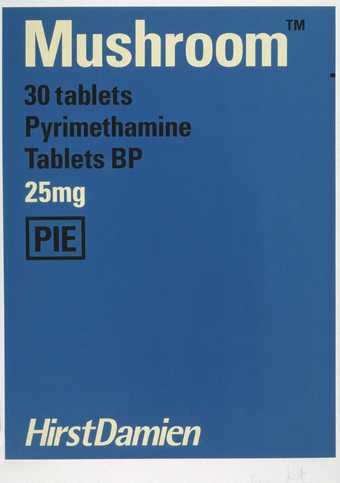
Damien Hirst
Mushroom
(1999)
Tate
Pop art’s bright colours and simple shapes can be seen in paintings and prints by Patrick Caulfield whose food inspired works such as Sweet Bowl and Bananas and Leavesexplore the decorative aspects of shapes and colour.
Play with your food
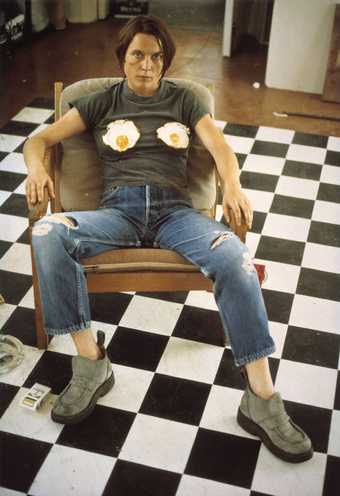
Sarah Lucas
Self Portrait with Fried Eggs
(1996)
Tate
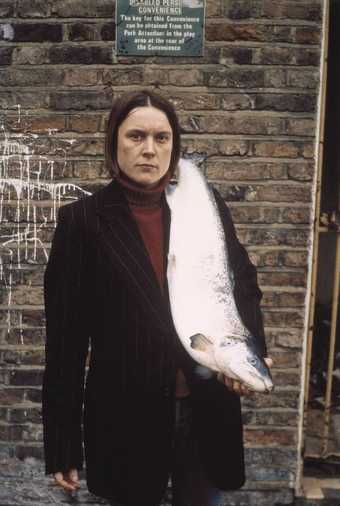
Sarah Lucas
Got a Salmon On #3
(1997)
Tate
YBA artist Sarah Lucas is an artist who enjoys playing with her food. In Self portrait with Fried Eggs, one of a series in which she depicts herself interacting with food, she presents an identity which challenges stereotypical representations of gender and sexuality. Posing simultaneously as tough and macho but female (humorously using the fried eggs to suggest breasts), she creates an image of defiant femininity.
Surrealist artists often used familiar objects but represented them in an unexpected way or placed them in unexpected settings to create unsettling images. (Psychologist Lucian Freud who was a huge influence on the surrealists referred to this as ‘the uncanny’). Marcel Duchamp, placed sugar cubes incongruously into a cage to create the oddly poetic and strange sculpture Why Not Sneeze Rose Sélavy?; Humphrey Jennings based his painting Swiss Roll, on a collage he made, where he stuck a picture of the tea-time treat onto a painting of Swiss mountain the Matterhorn.
In his Curious series artist Richard Deacon invents a series of comical characters based on misshapen fruit and veg, whose strange shapes look like human features.
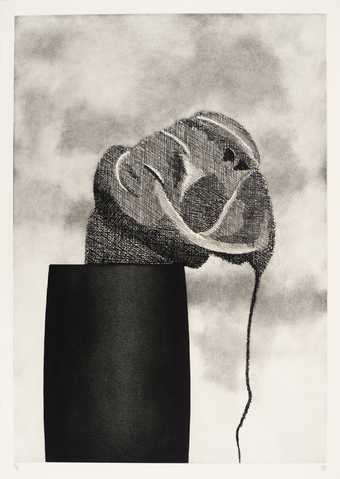
Richard Deacon
A Curious Carrot
(1991)
Tate
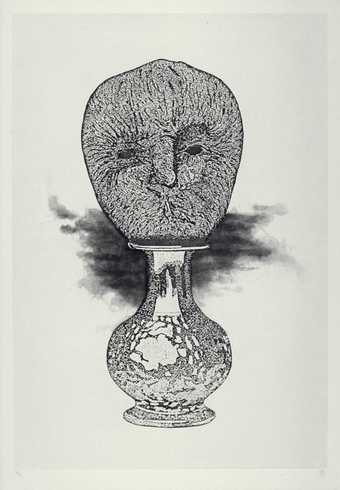
Richard Deacon
A Curious Apple
(1991)
Tate
Food for thought
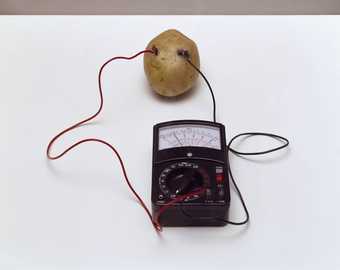
Victor Grippo
Energy of a Potato (or Untitled or Energy)
(1972)
Tate
It is not just the shapes, textures and colours – or packaging – of food that has been the subject of food-related art. Artists often use food symbolically to represent an idea. Artist Victor Grippo celebrated the power of the humble potato as a staple food for the world poor. In Energy of a Potato he attached electrodes to a potato in order to measure its electrical charge.
Conceptual artist Marcel Broodthaers used mussels as a symbol of his national identity (mussels are a national food of Belgium). For Daguerre’s Soup he photographed the ingredients of an invented soup to reference and celebrate Louis Daguerre, one of the nineteenth-century inventors of photography.
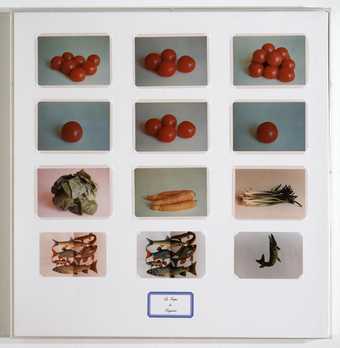
Marcel Broodthaers
Daguerre’s Soup
(1975)
Tate
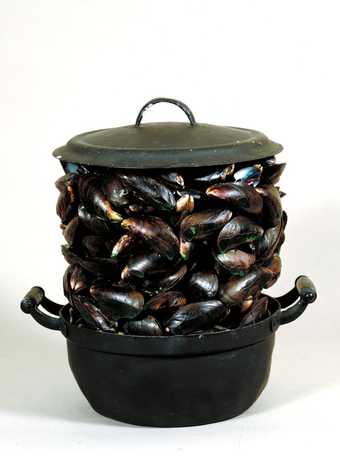
Marcel Broodthaers
Casserole and Closed Mussels
(1964)
Tate
In Flemish sixteenth century still life paintings, food – especially fruit – was often symbolic of the passing of time and shortness of life. Artist Sam Taylor-Johnson updated this idea in her work Still Life 2001. Through the use of time-lapse digital video she shows a traditional-looking display of fruit transforming before our eyes into a collapsed mass of rotting matter. Presented in a loop, the passage projects an endless repetition of life and death.
Keith Arnatt also used rotting food as the theme of his series of photographs Pictures from a Rubbish Tip. In his photographs Arnatt often transforms the ordinary and ugly into something extraordinary. His photographs of decomposing food are surprisingly beautiful. The colours, textures, carefully composed arrangements and ephereal quality of the images make them appear like old master still lifes.
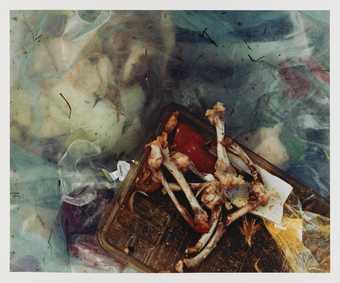
Keith Arnatt
Pictures from a Rubbish Tip
(1988)
Tate
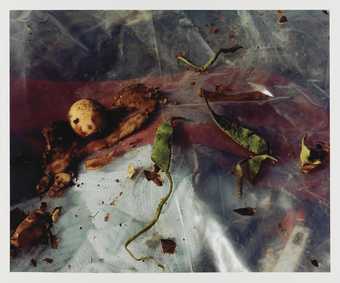
Keith Arnatt
Pictures from a Rubbish Tip
(1988–9)
Tate

Keith Arnatt
Pictures from a Rubbish Tip
(1988–9)
Tate


